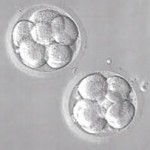We are experiencing a very high volume of calls and messages and ask for your patience. We will answer your portal messages within 48 hours.
We are experiencing a very high volume of calls and messages and ask for your patience. We will answer your portal messages within 48 hours.

 A common question I get asked is “How many embryos should I transfer?” Most of my patients want to get pregnant as soon as possible, and a significant percentage actually want twins.
A common question I get asked is “How many embryos should I transfer?” Most of my patients want to get pregnant as soon as possible, and a significant percentage actually want twins.
The logical answer, therefore, would be to transfer more than one embryo to achieve this outcome. However, this may not be the correct answer. Read on!
When patients say they “want” twins, they really mean they want healthy twins. The data clearly show that compared to singleton pregnancies, multiple pregnancies are high-risk. According to the Society for Assisted Reproductive Technologies (SART) a multiple pregnancy carries higher risks of complications to both the mother and infant.
Children born as twins are at significantly increased risks of cerebral palsy, learning disabilities, language delay and behavioral problems. These risks are even higher for triplets and quadruplets. Of primary concern is that these can be lifelong disabilities.
Compared to singletons, the risk of infant death is more than 4-fold higher with twins and 13-fold higher with triplets. Mothers pregnant with multiples are at increased risk for high blood pressure, diabetes, hospitalizations, and cesarean delivery.
The number of embryos transferred should be based on several factors. These can include:
The American Society for Reproductive Medicine (ASRM) has recently updated its recommendations for number of embryos to be transferred. The ASRM now recommends elective single embryo transfer (eSET) in patients up to age 37 years with good quality embryos.
SART has recently added a “Predict My Success” application on its website (www.sart.org). This helps patients find their individual success rate using this exclusive predictor tool. Click on the button, fill in the required fields and you get your personalized answer.
For a woman who is 35 years old, never pregnant, 5 feet 4 inches, 135 lbs., with unexplained infertility, the probability of live birth after one cycle is 41%, 61% after two, and 73% after three cycles.
With eSET (one cycle with one embryo) the probability of live birth is 40% and risk of multiple pregnancy is 2%. Two cycles with one embryo results in a 56% probability of live birth and risk of multiple pregnancy of 2%. Compare this to one cycle with two embryos, which results in a probability of live birth of 49% but a 33% risk of multiple pregnancy!
Thus, the cumulative live birth rate with two single embryo transfers is higher (56% vs. 49%) and there is a dramatic decrease in multiple pregnancy rate (2% vs. 33%)!
An excellent policy therefore is “Transfer as many embryos as you want to-- but only one at a time!”

Entire Website © 2003 - 2020
Karande and Associates d/b/a InVia
Fertility Specialists
